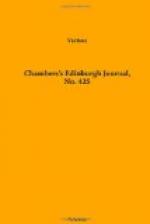However useful insects may be in the general economy of nature, it is but too true that farmers and gardeners often find them a pest, and with each returning summer the pages of agricultural journals abound with remedies, offensive and defensive, against the obnoxious invaders. In such cases, it becomes desirable to know what remedial means are the most efficacious, and we are glad to find that the question has been taken up by persons competent to discuss it. Among these, Dr J. Davy has given the results of his inquiry in a paper, ’On the Effects of certain Agents on Insects,’ which has just been published in the Transactions of the Entomological Society, and is well worth reproduction in a condensed form. The experiments were begun in the winter of 1850, the season, as will be remembered, being so mild that insects were readily met with. Their objects were threefold—to test the effects of temperature, of gases, and of vapours. In the former, recourse was had to extremes of heat and cold. A bee placed in a temperature of 32° became at first more active, but the next morning was found torpid, as if dead; a register-thermometer shewing that 25° had been the lowest temperature during the night. Transferred to a temperature of 52°, the bee revived in half an hour, and on the following day exhibited the same results under the same conditions. A fly which, on December 8, was lively on the wing, in a temperature of 52° indoors, was disinclined to move at 40°; and still more so, stirring only when touched, at 33°, but did not become torpid, as in the case of the bee, even at 23°, signs of life being distinctly visible. Several trials made with different species of flies all gave the same result—a remarkable power of sustaining life. The method adopted was to enclose the insects in a glass tube, and place them out of doors all night; and though the tube was frequently covered with frost, they soon revived in the warm temperature of a room. It is perhaps scarcely possible to estimate the degree of cold which insect life will bear without destruction, since many of these creatures survive the terrible winters of the arctic regions. Still, a knowledge of the effects of reduction of temperature will be valuable, as affording data by which to judge of the effects and probable duration of visitations of insects, and of the nature of the precautionary measures to be adopted. In an experiment of alternate temperature from 40° to 65° tried for five days on a bee, the creature at last ‘ceased to give any sign of vitality.’
The influence of heat appears to be much more rapid than that of cold: a fly exposed to a temperature of 120°, died in two or three minutes; and 113° proved fatal to another; while a third, placed in a temperature increased gradually to 96°, remained alive for more than an hour. Others bore from 80° to 90° for two hours; and in one instance, a fly survived from 86° to 100° for several hours, but became uneasy with




